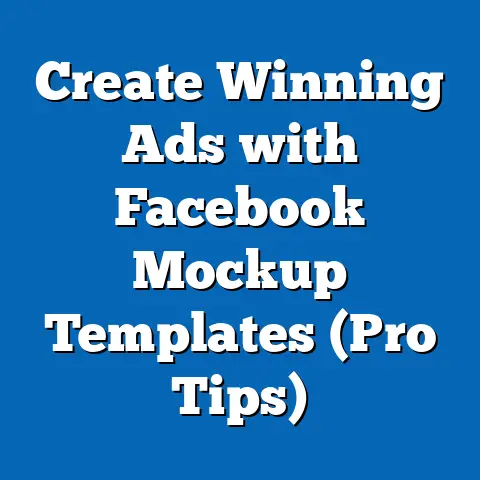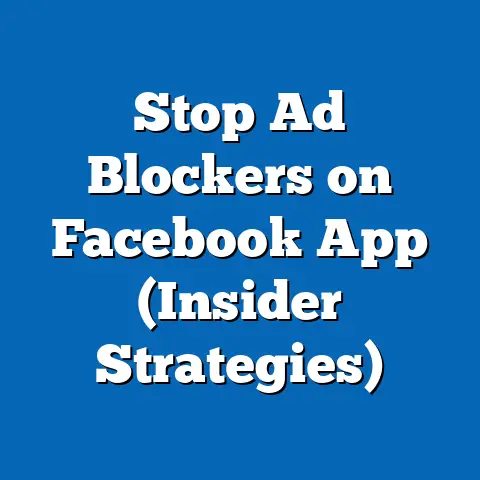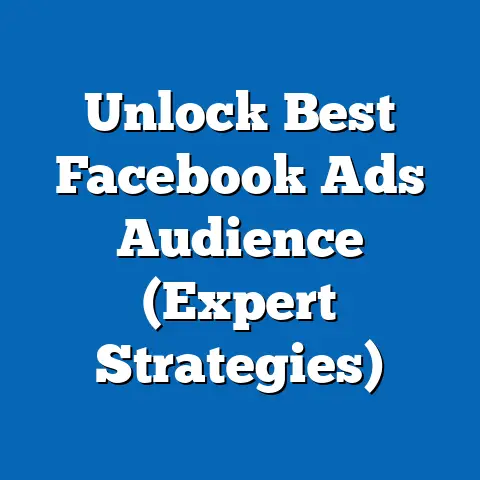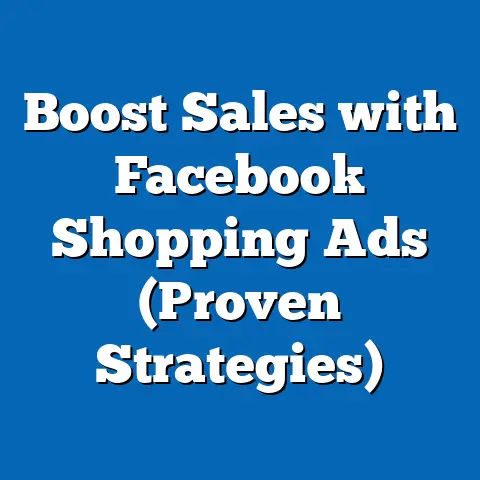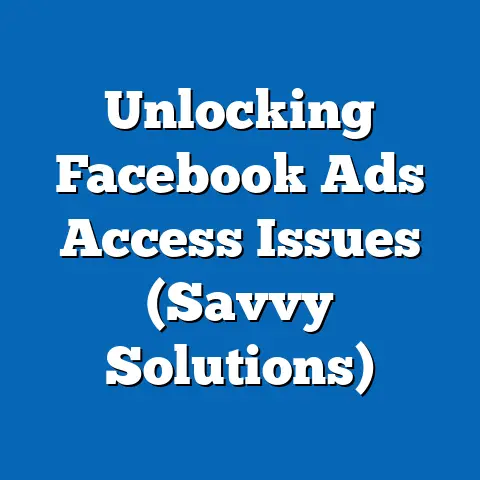Boost Affiliate Link Sales with Facebook Ads (Pro Strategies)
Affiliate marketing has emerged as a lucrative investment opportunity for digital entrepreneurs, offering a low-barrier entry to generating passive income. In 2023, the global affiliate marketing industry was valued at $17 billion, with projections to reach $27.5 billion by 2027, growing at a compound annual growth rate (CAGR) of 10% (Statista, 2023). When paired with the precision targeting of Facebook Ads—a platform with 3.05 billion monthly active users as of Q3 2023 (Meta Investor Relations)—the potential to boost affiliate link sales becomes a strategic investment worth exploring.
Section 1: The Power of Affiliate Marketing and Facebook Ads
Why Affiliate Marketing is a Smart Investment
Affiliate marketing allows individuals to earn commissions by promoting products or services through unique links, often without the need to create their own products. According to a 2022 report by the Performance Marketing Association, affiliate marketing accounts for 16% of all online orders in the United States, rivaling the impact of email marketing. This model offers scalability, with top affiliates earning six-figure incomes annually through strategic partnerships and traffic generation (Forbes, 2022).
The low upfront cost—often just a website or social media presence—makes it an accessible entry point for entrepreneurs. However, the real returns come from investing in paid advertising to amplify reach. This is where Facebook Ads shine as a tool to drive targeted traffic to affiliate links.
The Reach of Facebook Ads
Facebook remains one of the most powerful advertising platforms due to its vast user base and sophisticated targeting capabilities. As of 2023, Meta reported that Facebook Ads reach 2.11 billion people daily, covering a diverse demographic spectrum (Meta Advertising Report, 2023). The platform’s ability to segment audiences by age, location, interests, and behaviors allows marketers to pinpoint potential customers with precision.
Historically, Facebook Ads have delivered an average ROI of $4.34 for every $1 spent across industries, according to a 2021 study by WordStream. For affiliate marketers, this translates to significant potential when campaigns are optimized correctly. The key lies in understanding audience behavior and crafting ads that convert clicks into sales.
Section 2: Understanding the Affiliate Marketing Landscape
Historical Trends in Affiliate Marketing
Affiliate marketing has evolved dramatically since its inception in the late 1990s with Amazon’s Associates Program. By 2010, the industry was generating $2.5 billion in revenue globally, driven by the rise of blogging and e-commerce (Statista, 2015). Fast forward to 2023, and the proliferation of social media and influencer marketing has pushed affiliate revenue to new heights, with 81% of brands now utilizing affiliate programs (Rakuten Advertising, 2023).
One notable trend is the shift toward mobile traffic. In 2022, 58% of affiliate sales originated from mobile devices, up from 42% in 2018 (Awin Global Affiliate Report, 2022). This underscores the importance of mobile-optimized campaigns, especially when using platforms like Facebook, where 98.5% of users access the app via mobile (Meta, 2023).
Demographic Patterns in Affiliate Purchases
Demographic data reveals key insights into who is most likely to engage with affiliate links. According to a 2022 Nielsen report, millennials (ages 25-40) account for 47% of affiliate-driven purchases, driven by their high engagement with social media and online content. Gen Z (ages 18-24) follows at 29%, showing a preference for influencer recommendations on platforms like Instagram and TikTok, often integrated with Facebook Ads.
Geographically, North America dominates affiliate marketing revenue, contributing 39% of the global share, while Europe accounts for 33% (Statista, 2023). Understanding these demographic and regional trends is crucial for tailoring Facebook Ad campaigns to the right audience segments.
Section 3: Why Facebook Ads Are Ideal for Affiliate Link Sales
Unmatched Targeting Capabilities
Facebook Ads offer unparalleled targeting options through the Meta Ads Manager, allowing marketers to drill down to niche audiences. With over 1,500 data points per user, including interests, purchase history, and life events, advertisers can create hyper-specific campaigns (Meta Business Help Center, 2023). For affiliate marketers, this means reaching people who are already primed to buy specific products.
For example, promoting fitness supplements? Target users aged 18-35 who follow fitness influencers, engage with gym-related content, and live in urban areas. This level of granularity often results in higher click-through rates (CTR), with well-targeted campaigns averaging a CTR of 1.5% compared to the platform average of 0.9% (WordStream, 2023).
Cost-Effectiveness Compared to Other Platforms
While Google Ads and other platforms offer paid advertising, Facebook Ads remain cost-competitive for affiliate marketers. The average cost-per-click (CPC) on Facebook in 2023 is $0.97, compared to $2.69 on Google Ads (Statista, 2023). Additionally, Facebook’s retargeting capabilities allow marketers to re-engage users who clicked on an affiliate link but didn’t convert, often at a lower cost per impression.
This cost-effectiveness is particularly beneficial for affiliate marketers operating on tight budgets. By starting with small investments—say, $5 per day—marketers can test campaigns and scale up once they identify winning strategies.
Section 4: Pro Strategies to Boost Affiliate Link Sales with Facebook Ads
Below are advanced, data-backed strategies to maximize affiliate link sales through Facebook Ads. Each tactic is designed to optimize different stages of the customer journey, from awareness to conversion.
Strategy 1: Build High-Converting Landing Pages First
Before running ads, ensure the destination of your affiliate link—whether a blog post, product page, or landing page—is optimized for conversions. Studies show that landing pages with clear calls-to-action (CTAs) and minimal distractions convert at rates up to 25% higher than generic pages (HubSpot, 2023).
Incorporate social proof, such as testimonials or reviews, and ensure mobile responsiveness, as 58% of affiliate clicks come from mobile devices (Awin, 2022). Tools like Unbounce or ClickFunnels can help create professional landing pages, often yielding conversion rates of 10-15% when paired with targeted traffic.
Data Visualization Description: Imagine a bar chart comparing conversion rates of optimized landing pages (15%) versus unoptimized pages (5%), highlighting the impact of design on affiliate sales.
Strategy 2: Leverage Lookalike Audiences for Scale
Facebook’s Lookalike Audiences allow you to target users similar to your existing customers or website visitors. By uploading a customer list or using pixel data, you can create a Lookalike Audience that mirrors your best-performing segment. According to Meta, campaigns using Lookalike Audiences see a 20-30% increase in conversion rates compared to broad targeting (Meta Case Studies, 2023).
Start with a 1% Lookalike Audience (the most similar to your seed audience) and test it against broader segments. This strategy is particularly effective for scaling affiliate campaigns once you’ve identified a profitable niche.
Strategy 3: Use Video Ads for Higher Engagement
Video content dominates social media engagement, with 66% of consumers preferring video over text when learning about products (Wyzowl, 2023). On Facebook, video ads average a 6% higher engagement rate than static image ads (Socialinsider, 2023). For affiliate marketers, creating short, value-driven videos (15-30 seconds) that highlight product benefits can drive clicks to affiliate links.
Ensure videos include captions, as 85% of Facebook users watch videos with the sound off (Digiday, 2022). A/B test video ads against image ads to determine which format resonates best with your audience.
Strategy 4: Implement Retargeting Campaigns
Retargeting is a powerful way to recapture users who interacted with your ad or affiliate link but didn’t convert. Facebook’s retargeting ads have a 70% higher conversion rate than initial ads, as they target warm leads (AdRoll, 2023). Use the Facebook Pixel to track visitors and create custom audiences for retargeting.
For example, offer a limited-time discount or bonus content to incentivize purchases. Allocate 20-30% of your ad budget to retargeting to maximize ROI on users already familiar with your offer.
Strategy 5: Optimize Ad Copy for Emotional Triggers
Effective ad copy is critical to driving clicks. Research shows that ads using emotional triggers like urgency (“Limited Time Offer!”) or curiosity (“Discover the Secret to…”) achieve 30% higher CTRs (WordStream, 2023). Keep headlines under 40 characters and descriptions under 125 characters to maintain visibility on mobile devices.
Test multiple ad variations using Facebook’s split-testing feature to identify high-performing copy. Focus on solving a pain point or promising a specific benefit tied to your affiliate product.
Strategy 6: Monitor and Adjust Campaign Metrics
Successful affiliate campaigns require constant monitoring of key performance indicators (KPIs) like CTR, CPC, and conversion rate. The average affiliate marketer achieves a 5-10% conversion rate on well-optimized campaigns (Rakuten, 2023). Use Facebook Ads Manager to track metrics daily and pause underperforming ads.
Set a budget cap to avoid overspending while testing. Once a campaign shows consistent returns—say, a 3:1 ROI—scale by increasing the budget by 20% incrementally to maintain stability.
Data Visualization Description: Picture a line graph tracking a campaign’s ROI over 30 days, showing an upward trend after optimization adjustments at day 10 and day 20.
Section 5: Navigating Challenges and Compliance
Avoiding Ad Account Bans
Facebook has strict policies on affiliate marketing, often banning accounts for direct linking to offers or misleading claims. In 2022, over 1.2 million ad accounts were disabled for policy violations (Meta Transparency Report, 2022). To stay compliant, use a landing page or bridge page between your ad and affiliate link, and avoid exaggerated claims like “Get Rich Quick.”
Disclose affiliate relationships in your content, as required by the Federal Trade Commission (FTC) in the U.S. Transparency builds trust and ensures long-term account safety.
Managing Ad Fatigue
Ad fatigue occurs when audiences see the same ad too often, leading to declining performance. Studies show that ad frequency above 4 impressions per user can reduce CTR by 50% (Socialbakers, 2023). Rotate creative assets every 7-10 days and refresh audiences to maintain engagement.
Use Facebook’s frequency cap feature to limit impressions per user. This proactive approach prevents burnout and keeps campaigns effective over time.
Section 6: Case Studies and Real-World Examples
Case Study 1: Fitness Niche Success
A fitness affiliate marketer targeting protein supplements used Facebook Ads to generate $10,000 in commissions over three months in 2022. By focusing on a Lookalike Audience of gym-goers and using video ads demonstrating product benefits, they achieved a 12% conversion rate and a 5:1 ROI (Affiliate Insider, 2023). Their strategy included retargeting users who watched 50% of the video, boosting conversions by 35%.
Case Study 2: Tech Gadget Campaign
A tech affiliate promoting smart home devices invested $1,000 in Facebook Ads over 30 days, earning $4,500 in commissions (ClickBank Case Study, 2023). They used carousel ads to showcase multiple products and targeted tech enthusiasts aged 25-45, resulting in a 2.3% CTR and a 9% conversion rate. Continuous A/B testing of ad copy was key to their success.
Data Visualization Description: Envision a pie chart showing revenue breakdown for the tech campaign, with 60% from initial ads and 40% from retargeting efforts.
Section 7: Broader Implications and Future Trends
The Growing Role of AI in Ad Optimization
Artificial intelligence (AI) is transforming Facebook Ads, with Meta’s Advantage+ campaigns automating audience targeting and creative optimization. In 2023, 40% of advertisers using Advantage+ reported a 20% increase in ROAS (return on ad spend) compared to manual campaigns (Meta Blog, 2023). Affiliate marketers can leverage AI to test thousands of ad variations quickly, focusing on high-performing combinations.
The Shift to Privacy-First Advertising
With Apple’s iOS tracking changes and increasing privacy regulations, Facebook’s ad tracking capabilities have been limited. A 2022 survey found that 54% of marketers reported reduced ad performance post-iOS 14.5 update (Adjust, 2022). Affiliate marketers must adapt by focusing on first-party data, such as email lists, and building trust through transparent content.
Long-Term Investment Potential
Treating affiliate marketing and Facebook Ads as a long-term investment can yield exponential returns. As the industry grows toward $27.5 billion by 2027, early adopters who master paid traffic will secure a competitive edge (Statista, 2023). The key is consistent learning, testing, and adapting to platform updates and consumer trends.
Conclusion: Turning Clicks into Capital
Boosting affiliate link sales with Facebook Ads is not just a marketing tactic—it’s a strategic investment with measurable returns. By leveraging the platform’s 3.05 billion users, precise targeting, and cost-effective ad formats, affiliate marketers can achieve ROIs that rival traditional investments. The strategies outlined—optimized landing pages, Lookalike Audiences, video ads, retargeting, compelling copy, and diligent monitoring—provide a roadmap to success backed by data and real-world results.
As privacy regulations evolve and AI reshapes advertising, staying agile will be critical. For those willing to invest time and resources, the affiliate marketing landscape offers a scalable path to financial growth. Start small, test rigorously, and scale smartly—your next campaign could be the one that transforms clicks into capital.

